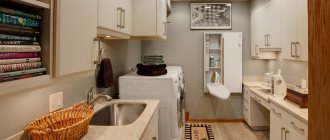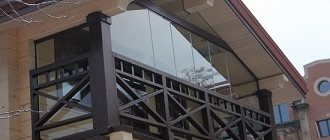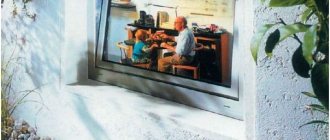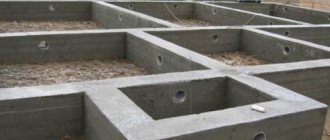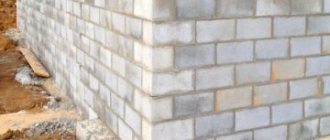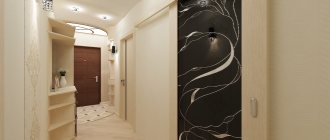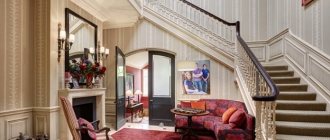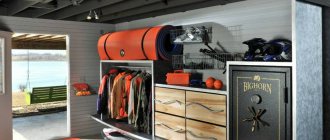To begin with, it is worth distinguishing between the concepts of basement, cellar and ground floor. The first room is part of the foundation; it is completely below ground level and is often adapted for the placement of communications. The ground floor is also called the “semi-basement”. This is a special room that rests on a foundation and is only partially buried in the soil. It is often equipped for garages and storage rooms. A cellar (underfloor) can be either a separately constructed building or the basement itself. It is usually used to store household equipment, preparations and vegetables for the winter. Basements have no windows, no natural light enters them, and thanks to the thermal insulation properties of the soil, the same temperature is maintained at any time of the year. After construction, they are rarely finished; they are left in rough form, since unnecessary work is associated with additional expenses. In many private houses, basements occupy an impressive area, which sooner or later the owners think about converting. As you know, nothing is impossible, so let’s find out in detail what work needs to be done to “domesticate” this room.
How to make your basement comfortable
A basement will only become comfortable if all work on its construction and finishing is carried out in accordance with generally accepted standards. Then you won’t have to go out every year in a “death battle” with mold, remove frost from jars of pickles in winter and sort frozen vegetables. To make the premises suitable for habitation, several stages of work must be completed:
- Carrying out heating, ventilation systems and electrical wiring. Unfortunately, you won’t be able to stay indoors for a long time without batteries, even in the summer; if there are no outlets, the use of equipment is impossible, and neither guests nor owners will want to breathe stagnant air;
- Finishing. In this case, we are talking about the use of especially durable heat and waterproofing materials that will help reduce the percentage of humidity and stabilize the temperature;
- Selection of furnishings and room design.
If no mistakes were made during construction and finishing, then the room will be no different from an ordinary living room in a house.
Glazing
In fact, glazing technology is very important, but the greatest heat loss occurs through the glass unit area. In addition, the fragile glass material is easy to break into and enter the home.
Advice! Protecting basement windows is a very important point. Ask the manager at the salon if they can equip the structure with anti-burglary fittings. This will certainly increase the cost, but if you install an armored double-glazed window in such a window, you can do without installing bars on the basement windows.
There are several booking options: from sticking an anti-vandal film to installing a triplex. The higher the degree of protection, the more expensive the design.
Triplex is an excellent replacement for bars on windows
To reduce heat losses, equip the structure with energy-saving double-glazed windows. The cost of the structure will change slightly - within 5-7%, but the savings on heating will be very significant, up to 30% of the previous budget.
We plan at the design stage
Those who are building a house face many questions: from the number of floors of the house to the need to arrange a basement in it. The latter will significantly increase the cost of the work, but additional space will never be superfluous either at the dacha or in the cottage. In addition, basements strengthen the foundation, which is especially important in those regions where outbreaks of increased seismic activity are observed. Any construction must begin with a soil survey. Its composition on the site and the depth of groundwater will matter. Depending on these two indicators, the type of foundation is selected, and, accordingly, the features of the basement:
- Monolithic (tiled);
- Tape.
The second type is suitable for deep-lying waters and soil that ensures the stability of the building. Monolithic is a solid slab. It is used for more monumental structures in places where the groundwater level rises above the critical level - 2 m, and the soil is loose and consists mainly of sand. Construction traditionally begins from the basement. The first is to dig a pit, lay the foundation, and arrange a blind area. There are two main technologies for building a basement:
- With the preparation of the pit;
- With preliminary pouring of strip walls (reinforced concrete).
Pseudo-windows
In a room where there are few windows, a person experiences discomfort, so the “light wall” or “pseudo window” technique was developed. It consists of the following: a double-glazed window, a frame are attached to the place where the window should be, and lighting is installed. Panoramic photo wallpaper with a city landscape is glued to the inside of the glass (and blinds are attached as a decorative element). Thus, a person will not experience psychological discomfort, and the interior of the room becomes more familiar.
A light wall is a way to “deceive” the body and prevent the appearance of unpleasant sensations associated with the lack of natural light sources. The technique works by creating the illusion of a large window, which allows you to get rid of the discomfort that arises from the feeling of a closed space.
Availability of basements
The entrance to the basement should also be present on the building design. There are only three options for its location:
- From the street;
- From home;
- Combined option.
In the first case, the basement will be considered as a completely independent room. Often closets are equipped with such an entrance, because gardening equipment is inconvenient to constantly carry through living rooms, staining the floors with earth. The entrance from the house is equipped for constant access to food supplies or to the living space. Doors can be wooden or metal. If the exit leads to the street, then it is better to choose a more durable and strong material. Metal will cope with this task better than wood. The second is chosen for interior doors, which are installed at the exit to the house. By type of execution they are classified into:
- Deaf;
- Panel;
- Paneled;
- Stained glass.
The latter must be purchased from heavy-duty glass. If the basement has not been renovated for living, then to avoid dampness or cold from the “dungeon”, choose double doors or combined with cladding. In some basements there are two exits at once: one to the residential part of the house, and the second directly to the street. In the first case, an interior door is used, and in the second, an entrance door.
Location nuances
Such products are characterized by non-standard placement. Let us consider in more detail the features of the location of structural elements:
- the structure is brought as far below the level of the base as possible;
- the structure is mounted close to the ground;
- products are small in size;
- Structural elements require protection.
Familiarize yourself with all the nuances before installing windows on the ground floor
Important. Experts do not recommend recessing the windows in the basement into the room, as this may cause destruction of the foundation, as a result of which the building will not last the expected period of time without appropriate repairs.
Read more: renovation of the building's basement.
How to finish
Before you start decorating, you will have to go through a difficult stage of rough work. It is not so pleasant, but without proper finishing the room will not have ventilation, communications and heating. The base of the future flooring, or screed, as builders call it, is created first. In a monolithic foundation, concrete is impregnated with special solutions, which, upon contact with moisture, crystallize and tightly “seal” the floor. If a tape-type base has been laid, then a real “layer cake” made from materials is laid on it:
- Sand cushion;
- Roofing felt layer;
- Reinforcing mesh.
And only the screed is laid on top. After the rough stage of working with the floor is completed, it can be safely covered with laminate, linoleum, parquet or ceramic tiles. The choice of material depends on the room design project. If the basement will be used for living, then a heating system will be provided between the flooring and the screed, which will ensure regular heating.
The walls are primed several times before final finishing. Two or three layers of antiseptic composition will not only improve the “adhesion” between the surface and the material, but will also reduce the risk of the formation of fungi and mold. In the future cellar or pantry, the walls are simply plastered or lined with wood panels and moisture-resistant plasterboard. The latter can be painted in the desired color if necessary. It is better to use mineral-cement plaster, as it is more resistant to moisture than its lime and gypsum counterparts. The wood will have to be treated with special solutions that will stop the processes of decay and the spread of fungus. In residential premises, insulation is carried out with mineral wool, and on top of the plaster the walls are finished with PVC panels, wallpaper, wood, plasterboard, or simply painted.
The ceiling in the basement plays an important role, especially if the room is being restored, and was previously used to carry out numerous communications. The hanging option will help you cleverly “hide” all this splendor from pipes and wires, but at the same time leave constant access to them if necessary. Unfortunately, this method is not suitable for basements with low ceilings, because its frame will “eat up” too many precious centimeters. In this case, it is better to resort to moisture-resistant drywall. In high basements, you can make a multi-level ceiling from this material, which will become the highlight of the interior. In simpler versions, the surface is primed and plastered.
The corners and all joints of surfaces in the basement must be coated with the waterproofing solution, which is used to impregnate the base to create the screed. This way you can protect the room from dampness and mold.
Choosing a staircase
The finishing of the semi-basement begins with the stairs. The overall impression of the interior of the room depends on its appearance. The modern construction market offers a wide variety of staircase options, and if you couldn’t find the right one from the entire range, you can always make it to order. But before placing an order, let's understand the types of staircase structures.
Stairs are divided into three main types: marching, bolt and spiral.
Steel flight staircase.
The peculiarity of the flight of stairs is its bulkiness. Unfortunately, not all semi-basements can accommodate such a structure. However, such a staircase looks very beautiful and is an important piece of furniture. If the size of your semi-basement allows it to be placed, you will have to decorate not only the steps and railings, but also devote time to the areas between the flights, as well as the walls along them.
Bolt version of the staircase.
A bolt ladder can only be installed if there is a load-bearing wall (the ladder will be installed along it). The bolt staircase is a reliable and durable structure, which in skillful hands can become the main decoration of the room.
Spiral staircase.
The spiral staircase is characterized as the most inconvenient for descending and ascending, however, the undeniable advantage of such a staircase is its compactness. It does not take up much space and fits perfectly into a small room.
As for the material from which the stairs will be made, there are no restrictions. Wood, glass and metal are used in its production.
Lighting
The wiring in the basement must be well insulated, as high humidity can play a cruel joke on the owners. If we are talking about a pantry or cellar, then even ordinary light bulbs will not fit here. It is necessary to choose special ones with a high level of moisture protection. This also applies to sockets: their design includes special caps that prevent liquid from getting inside. In residential basements, the lack of windows will have to be compensated for by numerous lighting fixtures, which are located at different levels. If your ceiling has several “steps,” then the point light sources built into them will become an interior element of the room, emphasizing its style. A chandelier or several equidistant from each other must be hung at the top if there are two (or more) combined platforms in the room. Sconces are attached to the walls, lamps are placed on tables, and floor lamps are placed on the floor.
A fireplace will bring a special flavor to the basement room. Its installation will be expensive, since due to the nature of the room you will have to hire a professional. The average person will not be able to cope with the task with his own hands. It is difficult to consider a fireplace as a source of light, but it is definitely a “source” of warmth and comfort in the atmosphere of the room.
Ceiling and lamps
The ceiling in any room plays a significant role. Proper finishing of the ceiling allows you to make rooms visually wider, disguise communications and even divide the room into zones.
Stretch ceiling with lamps.
Since quite a few UV rays enter the semi-basement room, it is necessary to take care of good artificial lighting in advance. To do this, you will need a lot of lamps, which are best distributed evenly across the ceiling. To give the ceiling a sophisticated look, you can use suspended structures and multi-level designs. Of course, if the height of the room allows it.
Mirrored or glossy ceilings will help make the room visually a little higher. This also allows for improved lighting levels. The reflective properties of the coating will create the effect of greater height. An excellent addition to such a ceiling would be “eyes” (the so-called spotlights that are mounted in the ceiling). They help not only to “raise” the ceiling, but also to make the room brighter.
Another option for ceiling lights.
Curved suspended ceiling, available for basements with high ceilings. Otherwise, you should give preference to a glass ceiling and place the lighting inside.
Ventilation
Regardless of what needs the basement will be used for, air exchange must be established during construction. Even if the finishing of the room was done correctly, with the walls impregnated with special solutions, if air circulation is disrupted, moisture will stagnate. Unfortunately, this is fraught with the appearance of fungus and mold. Spores of the latter can enter the lungs along with the inhaled air, multiply there and provoke a number of chronic diseases, some of which are fatal. Ventilation systems in the basement are classified into two types:
- Artificial;
- Natural.
The latter are suitable only for “cold” basements, which no one plans to equip for living quarters. Natural ventilation is a simple pipe system that connects a room with the street. The air circulates freely in them. Artificial or forced ventilation systems pump fresh air into the room from the street, and pull stale air out of it. Modern split systems are able to regulate the level of humidity and temperature within the regime set on the control panel. Such “smart” ventilation will eliminate many problems and become a universal “climate control” in the basement of a private house.
Briefly about the main thing
Many private homes have basements that can be converted and used more efficiently. Before turning the ground floor into a living room or gym, you need to take care of creating a comfortable living environment. To do this, they think through ventilation, heating and water supply, install sockets, and install an Internet cable.
Particular attention is paid to external and internal insulation of the basement. Proper thermal insulation is especially important if there is a sauna or swimming pool below. Regardless of how the basement will be used, other details must not be forgotten: safety, accessibility, choosing a suitable staircase. Most often, a living room, gym, games room or workshop is located on the ground floor.
Ratings 0
How to keep warm
To get a high-quality insulated basement, act in two directions:
- Conducting a heating system;
- Insulation of the “box” of the room: walls, ceiling and floor.
Heating systems will artificially increase the temperature and pump in heat. The task of insulation materials is to hold it for as long as possible. The quality of finishing and heating system directly affects the microclimate in the basement.
Insulation of the basement part
Insulation of the basement of the house is also necessary, as is the insulation of the roof and walls of the house. The energy efficiency of the entire house depends on correctly performed basement insulation work.
The most optimal material for insulation is extruded polystyrene foam. Polystyrene is produced in slabs, so the material is easy to install.
Polystyrene foam is cheaper, but it is not durable enough and will need frequent replacement. After installing the insulation, the basement of the house is finished.
Basement options
The basement is adapted to a variety of needs depending on the needs of the owners. In most homes, this room has impressive dimensions, which makes dreams of spacious areas for play, entertainment or work come true. Most often they create from the basement:
- Gym;
- Wine cellar with tasting area;
- A miniature bar for gatherings with friends;
- Swimming pool or sauna;
- Workshop for work;
- Laundry room for washing and ironing things. Relevant if the family is large;
- Billiard room combined with a darts and table tennis area;
- Games room;
- A greenhouse for growing vegetables or mushrooms. A kind of small household that doesn’t care about winter;
- A music studio with good sound insulation;
- Additional room for guests;
- Home cinema;
- Library and miniature reading room.
Place to rest
A place to relax in a spacious basement usually includes several functional areas:
- Reading corner;
- Bar counter for those who want to have a glass or two of wine;
- A platform for active games, and if dimensions allow, then even a miniature dance floor;
- Movie viewing area.
In small rooms you will have to limit yourself to one or two most important areas. The decoration of the basement room can be complemented by a cozy fireplace and firewood. They look especially colorful in rooms decorated in the now popular chalet style. The furnishings of the room have references to a holiday home, which is lost in the Alps, far from the bustling world. The chalet loves the abundance of wood, animal skins (imitation), brown-honey color scheme. Of course, the Alpine style is difficult to implement without the presence of panoramic windows with views of the mountains, but they are compensated for by false panels and an abundance of lamps of simple shapes. The fireplace is an integral part of the chalet. It is decorated with stonework or brick, and the fire doors are decorated with intricate ligature or ornaments, which are reflected in wall decoration and textiles. Please note that there should not be too many patterns; monotony prevails in the chalet.
Home cinema
In cottage houses, the basement is often equipped with a full-fledged mini-cinema. Films are viewed both on a modern large-format “plasma” of impressive dimensions, and on a white wall using a projector. The last option fits organically into the retro style. Seating can be arranged in several ways:
- Single chairs arranged in rows;
- Full-sized chairs with common armrests, like in real cinemas;
- Several sofas placed one after another.
The latter option allows, if necessary, to use the room for other recreation, therefore it is considered universal. A simple but sophisticated loft is suitable for a stylish cinema.
Library
A small basement can be converted into an individual room “for books”. The racks are installed solid: from the ceiling to the floor. A cozy place for reading or working is created in the corner. A soft sofa with a couple of pillows, a table and a couple of poufs for guests is enough. If you decide to place all your book treasures in the basement, then pay special attention to the fight against humidity. Over time, the paper may “bloom” in the bad sense of the word, and you risk losing your entire library.
Playroom for children
A residential basement is a gift for owners of a home “kindergarten”. If you arrange it tastefully, it will be difficult to pull the kids out of there. One area is allocated for creative activities: there are tables with chairs and a rack with kits for drawing, modeling, wood carving, modeling or creating crafts. Another area is designed for active games: table hockey, tennis, twister, trampoline, ball pool, rock climbing, children's darts. The third zone will be equipped as a resting place for children and an observation post for parents. On another site they usually embody a fairy tale for girls: with miniature castles, artificial trees and other attributes of the “kingdom of dreams.” Boys are given the opportunity to entertain themselves with construction kits and car racing on special tracks.
Gym
Spacious home basements are ideal for organizing a personal gym. For residents of cramped apartments, this dream remains unfulfilled, but owners of country houses are given a unique opportunity to realize it in their homes. The room is sparsely decorated, without skimping on mirrors. Just like in a real gym, there should be a lot of them, so that a person can see not only the result of working on the body, but also problem areas that still have to be worked on. When installing exercise equipment, maintain the recommended distance between them to avoid injury hazards.
Cellar
The cellar can be adapted for storing homemade pickles or wines. Country style is suitable for the latter. The trend, which was born in the American outback, loves rough textures and a range of “woody” shades. The walls are decorated with decorative bricks, chandeliers are hung from the ceiling on decorative chains, and empty glass containers are stored in barrels. A wicker tasting table and a pair of matching chairs are also placed here. If you plan to store pickles and food in the cellar, then you can save on finishing. It is not necessary to install heating in this room; natural ventilation is sufficient. When storing pickle jars, avoid wooden racks in favor of their metal counterparts. To increase the service life of the latter, the material is coated with a protective layer against corrosion.
Engineering systems
Initially, the basements were intended to house all communication nodes. A pumping station is installed in this room if the owners are connected to an autonomous water source. A gas or electric boiler, which is responsible for heating the entire house, is also placed here, as is an electrical panel with plugs. Engineering systems rarely occupy the entire basement area. If it is being equipped as a living space, they are separated from the room by a partition or decorative wall, so as not to spoil the overall appearance.
Profiled sheet
Corrugated sheet is originally a roofing material, but is also suitable for covering the base. The profile sheet is cheaper than siding, and is also easy to install.
In addition to the material itself, all you need for the job is a metal saw and a screwdriver.
The corrugated sheet is lightweight and does not create a load on the foundation. The disadvantage of the material is that it is susceptible to rust and rotting, and the beautiful color quickly fades in the sun.
Digging a basement yourself is not a good idea.
Digging a basement under an already constructed building is dangerous. Not every professional will undertake such work. To begin with, it is worth remembering that the basement is part of the foundation. It is developed at the design stage. Do-it-yourself activities are fraught with distortion or destruction of the house itself. Wooden buildings can sag, and brick buildings can crack. Basement walls are usually a continuation of the strip foundation, which is buried, that is, the room and the foundation of the house are a single whole. It is much easier and more economical to pay extra according to the estimate during construction than to pay a tidy sum to professionals for the restoration of a house damaged by independent excavation work.
Horizontal waterproofing
At the connection between the foundation and the plinth, a waterproofing material is laid: rolled sheets based on bitumen, roofing felt or roofing felt. Also, waterproofing material is laid at the junction of the base and the wall.
Rolled sheets are laid overlapping, then all joints are filled with liquid composite. Lay in two layers.
Thus, waterproofing will not only reliably protect the walls from moisture, but will also smooth out some unevenness of the joining surfaces.
Types of base
When choosing the material and method of finishing the base, it is necessary to take into account its design. There are three arrangement options:
- Speaker. Suitable for walls of small thickness. It is necessary to additionally install a drip to drain water flowing from the walls.
- Flush with the wall. In this case, there is a possibility of condensation forming in the house.
- Sunken. In this case, the wall of the first floor is wider than the base
1- wall of the house. 2 - low tide. 3 - base.
Experts believe that a sinking base of a house is the most durable. The drainage system is designed in such a way that the foundation remains untouched.
Beautiful
Beautiful options for finishing the base:
Lining the base with artificial stone.
Clinker tiles.
Options for finishing the base of a wooden house.
Inexpensive
If the budget is not large, then the following materials can be used to decorate the basement of the house:
- OSB, DSP boards;
- decorative panels;
- siding.
